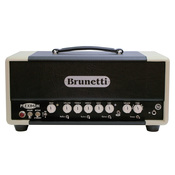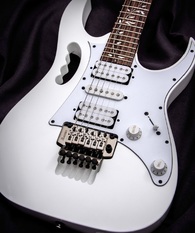 It’s not often that I choose to forgo plugging directly into one of my tube driven amps to experiment with some software based amp simulation interface like TH2. Thankfully I decided to do just that a few days ago. If it were not for that, I would never have heard the unique sounds of the Brunetti amp simulations that eventually lead me to search out some YouTube videos and ultimately discover the new Brunetti PlexiMan amp. I clicked on video link after video link and what I saw and heard intrigued me. Here I was listening to an Italian designed compact 50 Watt two-channel amp head complete with two-tone tolex and effects loop. It sounded wonderful through my speakers and I was pleased to discover that it also was switchable down to 5 Watts. I let the sounds and features linger in the back of my mind for a few days in the hopes that I would lose interest. I kept repeating that I really didn’t need another amp! A few more hours reading reviews on the forums as well as whatever few bits of information I could find online and I found myself e-mailing Brunetti for pricing. I was disappointed to learn that there were no distributors in Canada as of yet but surprised by how reasonable the price of the amp was. Of course, the marginally declining Euro was not in my favor as the Canadian dollar was still much weaker overall. A few e-mails with Mary at Brunetti and my PlexiMan was on order and would be shipping out in about one week. All my questions were answered quickly and Mary and I even exchanged a little World Cup Soccer talk and I told her I was hoping Italy would defeat Germany in the weekends game! The longest part of the whole process was upon me… Waiting for FedEx to arrive so I could finally hear in person what I’ve only had a teaser of online. Once FedEx dropped off the package, the first thing I noticed was how light the box was. After opening the box, I was pleasantly surprised at how compact the Brunetti was. I don’t really enjoy lugging around larger heavy amp heads anymore so this was precisely what I was looking for. Out of the box, the amp is stunning to look at, really nicely made. The two tone tolex was finished expertly and the handle of the unit felt high quality and sturdy enough to withstand daily use if required. It also came with an offer for a free Brunetti version of Overloud TH2 which is a nice additional perk I will take advantage of soon. The front panel of the amp was very easy to read with the white lettering on the black front panel. The white MXR style knobs were also easy to read and felt snug and solid to the touch. The front panel had 6 switches and a green power indicator light but more about the switches later. The amp cover was designed with a side pocket to conveniently store the footswitch. A nice touch! I pulled out the foot pedal from the amp cover with the large Brunetti logo silkscreened across the front of it and was pleased with how solid it felt. The unit was made of thick steel and even included a foam rubber base and 3 indicator lights for the amps 3 switchable channels. Hotrod mode, solo mode, and channel. The input jack for the footswitch was hardwired to the box. This is something that could end up getting damaged eventually, but the high quality, thick gauge wire put me at ease. It was also long enough to use onstage without any issues. The user manual was a little basic. It was a set of sheets printed in an inkjet printer and bound together. I’m not a big manual reader type of guy since I usually like to dive right in and figure it out as I go, but I thought it looked somewhat cheap. The information was clear enough, though. So let’s get to the meat and potatoes of the amp. I plugged in into my Marshall closed back 4-12 cabinet with vintage Celestion g12-65 speakers. I was surprised at how the amp sounded balanced with all the knobs set to the 12 o’clock position. Actually, I found it was a little difficult to actually get a bad sound out of it. Turning the knobs one way or another just gave you more flavor but never really brought you into a sound that was not pleasant like some other amps can sometimes do. Since you can switch to the hotrod mode from the pedal board, the amp is almost a three channel amp. I found that the amp interacted with my pedals very well. I normally like to play with an overdrive pedal on and just a little delay and some slight reverb for a little more sparkle. I felt that I no longer needed to use my Wampler Pinnacle or my Fulltone Plimsoul as the amp was able to deliver better overdrive tones than the pedals. This amp just may allow me to free up some space on my pedal board if I remove the overdrives. I did keep my EP booster pedal on however because I feel that unit pushes amps just enough and makes everything sound better. I felt that the amp interacted with the Celestion G12-65 speakers in a very, very nice way. I would like to try it into my open back 2 12 cabinet with a WGS vintage 30 and a WGS version of the G12-65 but I haven’t got around to it yet. The sound was full and not spikey or fizzy at all. The bottom end of the sound spectrum was perfect. Not boomy and not anemic either. I felt it would do very well in a live rehearsal situation. The 50-watt mode is loud enough to handle any band situation with ease. No worries there. The 5-watt mode works tremendously well in a bedroom setting. It can be lower volume if you want it to be, but can also be loud if you crank it. Always full and natural sounding. Most amps I’ve tried fail in the lower watt modes because I feel the amps tend to lose too much of their original character. I didn’t think the Brunetti did that at all. The sound still filled the room nicely and as a matter of fact, the 5-watt mode cranked up loud sounded very punchy indeed. It provided more tone than I expected from a 5 Watt amp. If I had to put a label on the tones the Brunetti can emulate, I would have to say it produces Billy Gibbons tones with ease. Think Tush, La Grange, or Sharp Dressed Man. It can also produce Van Halen I tones quite convincingly as well as other classic rock sounds. Compared to my hand-wired Marshall Plexi I can honestly say that the Brunetti PlexiMan is more flexible in that it has more useable tones as well as plenty of punch at lower volumes which the Marshall simply cannot do without some very heavy attenuation. Even with attenuation the Marshall never really gets into that Van Halen brown sound without being modified or using pedals to help it along. Being a one channel non master volume amp it simply needs to be cranked up louder than someone can support in a home setting. My only gripe with the Brunetti is the somewhat limited clean channel. With just a volume and a tone knob, I feel that you can’t really dial in a true sparkling clean tone. Maybe I have to spend more time in this channel but in all honesty, I tend to spend more time in the Hot Rod channel because it just sounds so darn good! I think the secret to attaining a really good clean tone with this amp is to stick with the Hot Rod channel. This may sound counter intuitive but trust me, if you increase the volume and decrease the gain while in the 50 watt mode you can get some excellent clean tones. Think Shine On You Crazy Diamond or even some Stevie Ray Vaughn. All you need is a little reverb and a Tube Screamer to push it a little. The switches on this amp such as the Mello, Extra, Hot Rod and Dense will allow you to spice up you primary tone in so many ways it is simply amazing. I tend to alter the setting of the switches depending on what channel and tones I am trying to achieve. The beauty of having these alternate setting at your disposal is that regardless of the type of guitar you are using, you can optimize the tone of the amp to work with it. Humbuckers or single coils work equally well. Pros:
Cons:
Overall I am extremely pleased with the Brunetti PlexiMan. It offers great value and tones without the extreme price tag typical of other boutique amps on the market. If you are considering a vintage British style amp for classic rock and roll tones, do yourself a favour and demo the Italian designed PlexiMan before purchasing your next amp. I honestly think very few amps currently offer this many features at this price point and build quality. I think you will be more than pleased. www.addictedtogear.com visit www.brunetti.it for more product information
4 Comments
 Ibanez JEM is the iconic electric guitar manufactured by Ibanez and first produced in 1987. The guitar's most notable and co-designer is Steve Via. As of 2010, there have been five sub-models of the JEM: the JEM7, JEM77, JEM777, JEM555, JEM333, and JEM70V. The Jem Jr. was released as a low-cost import to meet the demand of players looking for good value and reasonable price. With many fake Jem copies flooding the market these days, it difficult to be sure you are really getting an original Ibanez made guitar. Unless you buy the guitar from a reputable guitar store or have a really good eye you just may get scammed so buyer beware especially if you are looked for one on the used market. When I purchased the Jem Jr. I did so on a whim. I have been a big fan of Steve Vai since I was a teenager. Not so much for his music as for his technique and virtuosity. I will be honest and say that I don't even own one of his records. Don't judge me! I was looking for a guitar that didn't quite have the same sound or features as the other guitars in my collection. The Ibanez fit the bill very nicely. I like to compare this guitar to a sports car. Slim flat neck with wife frets makes it super easy to play. The vine of life inlay and monkey grip handle make it quite identifiable at first glance. The little things like the angled input jack add to the unique design it is well known for. The HSH configuration of the pickups gives you quite a bit of additional tonal range. Although players who are not used to this configuration may find themselves a little limited in picking space between pickups. Honestly, I don't really use the center pickup very much but I refuse to remove it because I want to stay true to the look of the original Jem. I feel that although the stock pickups in the Jem Jr are adequate, they are nothing that I consider impressive. Yes, they do the job, but I am certain that the guitar could benefit from a pickup upgrade if you are looking to squeeze the most out of this Ibanez. One aspect of the guitar that irks me a little is that they decided to go with a super white pick-guard instead of the off-white pearl version on the original. I can't help but feel that this looks out of place on the guitar. One can always purchase a replacement but I fear that the hole locations are not in the same location. So installation may be somewhat of a challenge without being forced to drill new holes. The bridge although decent is not nearly at the same level of quality as the original. I was not surprised to see that Ibanez opted to go with a cheaper version to keep costs down. Some people have voiced their disappointment in this area but using cheaper badges and electronics is a commonly seen tactic among guitar manufacturers looking to cut costs. I would say that the bridge on the JEM Jr is a mid-level bridge that for the most part hold tuning well enough. I have seen much much worse at around the same price point from other manufacturers which shall remain un-named. You always have the option of dropping in an original Floyd Rose if you intend to keep the guitar long term. The guitar setup was very well done out of the box. The action was low and comfortable. The fret edges we well rounded and not sharp and the bridge was floating level and adjusted properly. So no complaints in that department. Overall I think the Jem Jr is a very nice guitar although a little retro after all these years. It's not for everyone and some traditionalist may find that it is not for them, the 70's and 80's crowd will still get a kick out of this shredder guitar. www.addictedtogear.com |
AuthorWritten By: ATG editors Archives
December 2016
Categories |
ADDICTED TO GEAR
Addicted To Gear |
Vertical Divider
|
© COPYRIGHT 2017 "WWW.ADDICTEDTOGEAR.COM"
ALL RIGHTS RESERVED. |



 RSS Feed
RSS Feed
